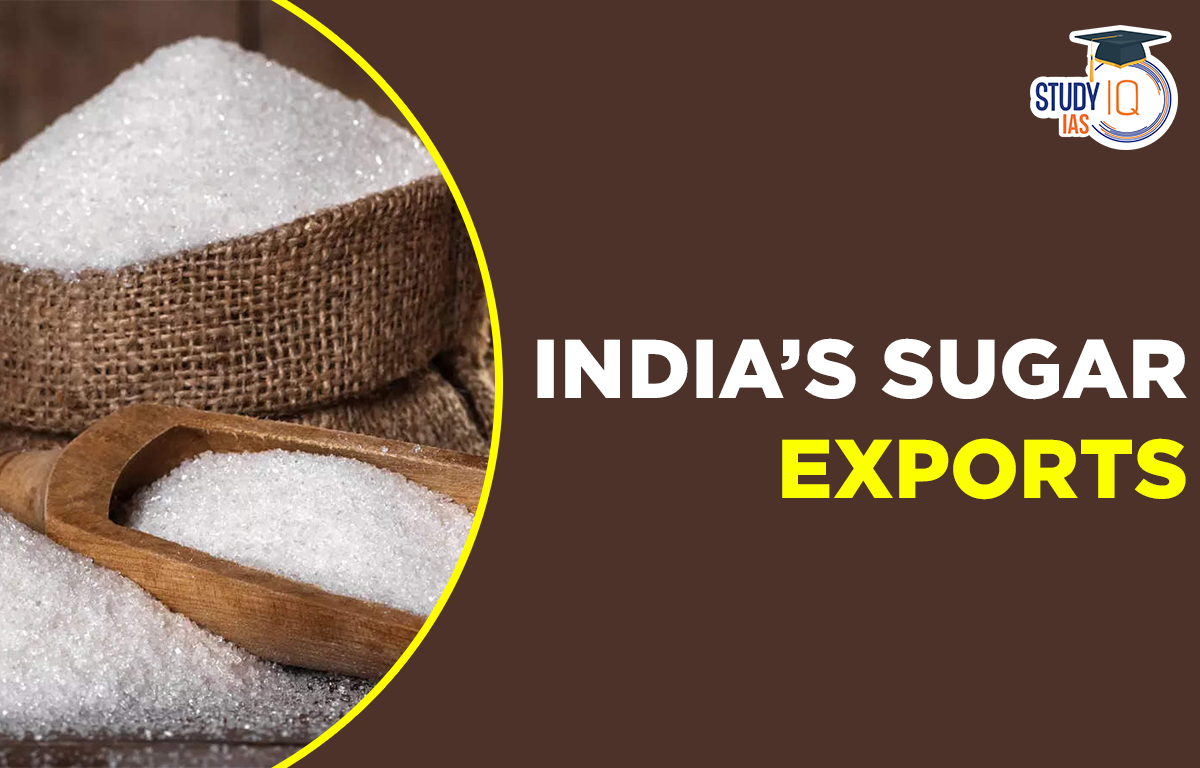Table of Contents
Context: As per the recent estimates, India has soared up from being a marginal player to world’s No. 2 behind only Brazil by pivoting to raw sugar exports.
More on India’s Sugar Exports News
- Surge in India’s sugar exports:
- In terms of value: Between 2017-18 and 2021-22, sugar exports have soared from $810.9 million to $4.6 billion, and could cross $5.5 billion – or Rs 45,000 crore – in the fiscal year 2022-23.
- In terms of volume: During the 2016-17 and 2017-18 sugar years (Oct-Sept), India’s shipments were a mere 0.46 lakh tonnes (lt) and 6.2 lt respectively, which zoomed to 110 lt by 2021-22.
- Raw sugar exports: India did not export much raw sugar until 2017-18, but in 2021-22, out of the total 110 lt sugar exports, raw sugar accounted for 56.29 lt.
- The biggest importers of Indian raw sugar were Indonesia, Bangladesh, Saudi Arabia, Iraq and Malaysia.
- White/refined sugar exports: The country also exported 53.71 lt of white sugar, the leading destinations for which included Afghanistan, Somalia, Djibouti, Sri Lanka, China, and Sudan.
What are Raw and White Sugar?
| Raw Sugar | White/refined Sugar |
| Raw sugar is what mills produce after the first crystallization of juice obtained from crushing of cane.
This sugar is rough and brownish in colour, with an ICUMSA value of 600-1,200 or higher. |
Raw sugar is processed in refineries for removal of impurities and de-colourisation.
The end product is refined white cane sugar having a standard ICUMSA value of 45. The sugar used by industries such as pharmaceuticals has ICUMSA of less than 20. |
| ICUMSA, short for the International Commission for Uniform Methods of Sugar Analysis, is a measure of the purity of sugar based on colour. The lower the value, the more the whiteness. | |
Why Raw Sugar Exports are Preferable?
- Ease of Transport and Distribution: Raw sugar is transported in large vessels as it requires no bagging or containerisation and can be loaded in bulk, while white sugar is packed in 50-kg polypropylene bags and shipped in small container cargoes over shorter distances.
- Time window: Refineries usually buy raw sugar from Brazil, whose mills operate from April to November, while India’s mills operate from October to April. India offered to sell their raw sugar to these refineries during Brazil’s off-season.
- Freight Cost Savings: The voyage time from Kandla, Mundra or JNPT to Ciwandan Port of Indonesia is 13-15 days, compared to 43-45 days from Brazil’s Port of Santos.
- Specific advantages of Indian raw sugar: Indian raw sugar has two specific advantages over sugar from Brazil, Thailand, and Australia.
- No dextran: Firstly, it is free of dextran, a bacterial compound formed when sugarcane stays in the sun for too long after harvesting.
- High polarization: Secondly, Indian mills can supply raw with a very high polarization of 98.5-99.5%, making it easier and cheaper to refine. Polarization is a measure of the sucrose content in raw sugar, expressed as a percentage.
- These factors have resulted in Indian raw sugar fetching a 4% premium over the global benchmark price.
About Sugarcane
- Sugarcane is a crop of tropical areas. Under rainfed conditions, it is cultivated in sub-humid and humid climates. But it is largely an irrigated crop in India.
- Distribution:
- In the Indo-Gangetic plain, its cultivation is largely concentrated in Uttar Pradesh.
- Sugarcane growing area in western India is spread over Maharashtra and Gujarat.
- In southern India, it is cultivated in irrigated tracts of Karnataka, Tamil Nadu, Telangana and Andhra Pradesh.
- Major producers: Uttar Pradesh produces about two-fifths of sugarcane of the country. Maharashtra, Karnataka, Tamil Nadu, and Andhra Pradesh are other leading producers of this crop where the yield level of sugarcane is high. Its yield is low in northern India.
About Sugar Industry in India
- 50 million sugarcane farmers & around 5L workers directly employed in sugar mills.
- India is the 2nd largest producer of sugar after Brazil – produces 15% of global sugar.
Challenges faced by Sugar Industry in India
- Cane reservation area and bonding: Every designated mill is obligated to purchase from cane farmers within the cane reservation area, and conversely, farmers are bound to sell to the mill.
- However, this arrangement reduces the bargaining power of farmers and restricts the mills’ flexibility in augmenting cane supplies and the quality of cane supplied by farmers.
- Minimum distance criterion: Under the Sugarcane Control Order, the central government has prescribed a minimum radial distance of 15 km between any two sugar mills. This regulation is expected to ensure a minimum availability of cane for all mills.
- However, this criterion often distorts the market by giving mills power over farmers, restricting competition, inhibiting entry, and further investment by entrepreneurs.
- Export restrictions: prevents better price discovery.
- Compulsory sugar packing in jute only: Increases the cost by about 40 paise per kg & adversely impacts quality.
- Other issues:
- High production cost of sugar compared to international levels.
- Seasonal nature of industry – mill and the workers idle for 6 months.
- Outdated technology – mechanical inefficiency of sugar mill.
- Reduced demand for sugars – alternatives like artificial sweeteners.


 Phone-tapping in India, Legal Framework ...
Phone-tapping in India, Legal Framework ...
 Bihar Assembly Election 2025 Dates, Poli...
Bihar Assembly Election 2025 Dates, Poli...
 Jharkhand High Court Assistants Admit Ca...
Jharkhand High Court Assistants Admit Ca...





















